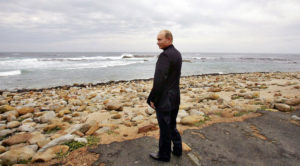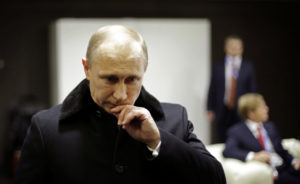“Beef & Liberty”. Such was the slogan of the 18th century London dining club, The Sublime Society of Beef Steaks. The carnivorous Regency gentlemen were sensible in associating the scoffing of sirloin with freedom and the rights of Britons. Food, like the personal, is political. With Russia’s invasion of “the breadbasket of Europe”, it is wheat, the most widely-grown crop in the world, that has been sucked into existential questions. But if meat tandems with liberty, then wheat, historically, comes chained to tyranny.
The blight that is wheat took root 10,000 years ago, when Triticum aestivum, or bread wheat, was domesticated from wild grasses in the “Fertile Crescent” of the Middle East. Initially, the local Neolithics cultivated wheat alongside traditional hunter-gathering and incipient pastoralism (livestock farming). But wheat is a slave-master, demanding in its specific and daily needs, not least the endless — or so it seems to us who have ever grown the stuff — weeding. Wheat locked us into a seasonal cycle of planting, weeding and harvesting from which we have been unable to escape ever since. It also made us more sedentary, both in terms of chaining us to static settlements, and becoming less active. Guarding a wheat field from wild boar requires less energy than hunting wild boar; the lineal ancestor of the couch potato was the campfire bun.
Crop-watching may demand little energy, but it is demanding of time. With fewer hours to hunt and to forage, we settled for a restricted diet. At Abu Hereyra in Syria, archaeology records this shift: when the occupants were hunter-gatherers, they consumed 150 wild plants; as arable farmers, they ate just a handful of crops. Human health deteriorated; the human body changed. Singularly, the jaw shrunk, since the new wheaty diet required less chewing than meat. Human teeth did not reduce proportionately to the smaller jaw, so dental crowding ensued. The diet of starch — wheat’s principal component — caused cavities. And the dietetic value of wheat, which was anyway only modestly nutritious, has declined by as much as 30% under contemporary industrialised agriculture.
The intriguing question is: if wheat-growing altered our corporeal structure, did it alter our brain? Did the systematic rituals and requirements of planting and harvesting wheat change our brains to make us more docile? Organised? Cooperative? Disconnected from nature? Did it turn us away from animism to praise of Ceres, goddess of grain crops, and then to an abstract, monolithic God of whom we ask our daily bread.
What wheat certainly did do was facilitate the rise of the state. As James C. Scott, co-director of the Agrarian Studies Program at Yale University, explains in Against the Grain, wheat became the best way to tax the people: “The key to the nexus between grains and states lies, I believe, in the fact that only the cereal grains can serve as a basis for taxation: visible, divisible, assessable, storable, transportable, and ‘rationable’.”
Wheat-fields are fixed and surveillable; livestock moves about. Counting sheep is easy in bed but for a state flunky on an arid hillside, the accurate checking of ovines (which are, anyway, easy to transport, and therefore to hide) is all but impossible. Similarly, communities reliant on tubers or root vegetables such as yams as their staple were more able to evade taxation since the crop can be left in the ground and harvested when the tax collector has gone home. Such societies rarely developed into states.
But where you have wheat, historically, you have state control or its like. The taxing of wheat enabled the emergence of non-productive elites, who required an armed wing to defend their regime. The food that fuelled the necessary population increase to staff the army, the fist of the state? Wheat. Nutrient poor but energy dense, fodder for the masses, it provided just enough energy and health to work, breed, fight. The early grain states were “population machines” (Scott again), domesticating people as the farmer domesticates the cow herd.
The most “domesticated” people were slaves, utilised in wheat’s more unpleasant aspects of production. Wheat states were slave states. The Roman writer Lucius Apuleius recorded in Metamorphoses IX the lot of millers:
“Their skins were seamed all over with marks of the lash, their scarred backs were shaded rather than covered with tattered frocks. Some wore only aprons, all were so poorly clothed that their skin was visible through the rents in their rags! Their foreheads were branded with letters, their heads were half-shaved. They had irons on their legs. They were hideously sallow. Their eyes were bleared, sore, and raw, from the smoke of the ovens. They were covered with flour as athletes with dust!”
To prevent the enslaved fleeing the dirty work, law and policing were invoked, even invented. The legal Code of Hammurabi (c1750 BC) has six clauses to punish the escape of slaves.
Western society was eventually organised around the production and consumption of wheat. And so it became the ultimate political tool. Communism’s iconography of a hammer for the proletariat and a wheat-cutting sickle for the peasantry turned out to be one of history’s crueller ironies. The hammer was taken to the workers, the sickle to the peasant. As well as being easy to tax, wheat is easy to confiscate. And since wheat is a subsistence crop, remove it and you have starvation. During the Holodomor, the Ukrainian famine of 1932-3, Stalin deliberately deprived the country’s population — who lacked sufficient ardour for rule from Moscow — of wheat. Some 3.9 million Ukrainians, about 13% of the population, perished.
Meanwhile Hitler, a few years later, planned to feed the unformed millions of his master race with wheat tended by Ukrainian slaves, or neger, in the Reich’s terminology.
But the tyranny of wheat can be more subtle than the feeding or impoverishing of the masses in totalitarian grain states, old or new. Since the Second World War, the chief agricultural aim of government (and transnational governments such as the EU) has been productivity: quantity over quality. Wheat farming has become a yield-obsessed industry dependent on labour-reducing but expensive technology. Unsurprisingly, it has become a cereal-killer of small, family farms: a brand-new combine harvester can cost £100,000. Farmers who do fork out for one become indentured to an agribusiness complex, which oversees their production of wheat from cultivation to sale.
One example will serve: farmers who participate in the “Climate View” bio-tech programme of chemical giant Monsanto supply harvest data through sensors on combines manufactured by John Deere; Monsanto then sends prescriptions back, telling farmers which product he or she should apply to maximise yield. In his book Perilous Bounty, Tom Philpott recounts an interview with an ex-Monsanto executive who “painted a future in which farmers would essentially outsource their decisions to Monsanto”. There is a Latin phrase for farmers in such corporate controlled agriculture: instrumentum vocale. Talking tools. Slaves.
Really, one becomes slyly indentured. Back in 1976, Monsanto developed the herbicide Roundup. They then genetically engineered wheat cultivars resistant to their own product, eventually mass-producing the Roundup Ready line of seed in 2019. Yes, you read that right: the grains were developed for their ability to cope with a chemical product that Monsanto wanted to flog. So if the farmer buys Roundup Ready seed, then he or she buys the tied-in Roundup herbicid. And Monsanto cashes in twice.
Chemical use in conventional wheat-growing does much for the coffers of Monsanto (now owned by Bayer), but it is turning swathes of the UK countryside into a coffin for nature. Wheat is the cause of more environmental problems than you can wave a baguette at. Although the lobbyists and the apologists of agribusiness insist that pesticide use has declined over the last quarter of a century, this is not the case when it comes to wheat. Between 2000 and 2016, average spray passes (applications) over wheat increased from 5.5 to 6.6, while the active substances in sprays went from 14.7 to 20.5. Actually, forget the mgs, and the ratios. The countryside is doused in chemicals.
According to Cornell University’s Environmental Impact Quotient (EIQ), which compares approximate toxicities for pesticides, an EIQ of 7 indicates toxicity to wildlife. The fungicide chlorothalonil, usually bought in the UK as Bravo, has an EIQ of 33; it is widely used on winter and spring wheat. Chlorothalonil is now banned by the EU. Extinction of nature is not confined to the savannah and the jungle. It happens at the cottage door. Five wildflowers — “weeds” to some — associated with cereal and arable farming in the UK are now dead and gone due to chemically addicted industrialised agriculture: So, farewell, Lamb’s succory, Interrupted brome, Thorowax, Small bur-parsley and Downy hemp-nettle.
The environmental woes of wheat go on and on. Yearly planting requires yearly tilling and this constant churning of earth kills the soil’s living organisms, spumes CO2 from soil-stored carbon, and exacerbates climate change. And I have not even mentioned the negatives of nitrogen as industrial wheat’s mainstay artificial fertiliser, what with its polluting run-offs and its release of nitrous oxide — a greenhouse gas which, pound for pound, warms the planet 300 times as much as carbon dioxide.
Of course, wheat has its champions. According to agribusiness’s advocates, industrial wheat production must continue if we are to satisfy the stomachs of a growing global population. There is not a grain of truth in this. Farming already provides more than enough food for the future; the problem is simply that the West wastes a third of its food, and less developed countries lose about the same amount due to poor processing and storage. Anyway, in a world going to fat and type 2 diabetes more carbs from Mother’s Pride sliced white are hardly necessary.
Humanity took a wrong turn with wheat. But all is not lost. If the Russian invasion of Ukraine is causing a rethink of our reliance on oil and gas, this too is the moment to sow seeds of doubt about our dependence on the “golden grain”. Why not grass over swathes of the arable prairies of East Anglia — and Ukraine — and stock them with free-range cattle and sheep? Grass requires no lashings of chemicals, and livestock dung is excellent at restoring soil fertility and biodiversity; a single cow can feed 2.2 million insects per year, which means snacks galore for the birds and the bats.
I know, I know, as every vegan will exclaim: “Cows belch methane”! But it is not the cow, it is the how. An outdoor cow, on established grass, with methane-reducing seaweed supplement and low stocking density, is actually sequestering carbon. So, bovines are less of a climate problem than synthetic clothes, given that trainers alone cause 1.4% of global greenhouse gas emissions. One can only presume that the Oxford councillors who took the decision recently to go “meat free” are nudists. Or stupid. Or anti-nature. Or all three.
To save the planet, pastoralism is the intelligent solution. The brain is 60% fat, and omega-rich fat from grass-fed meat is excellent for mental health. The sine qua non of free thinking. Beef and liberty! More meat, less wheat!
Disclaimer
Some of the posts we share are controversial and we do not necessarily agree with them in the whole extend. Sometimes we agree with the content or part of it but we do not agree with the narration or language. Nevertheless we find them somehow interesting, valuable and/or informative or we share them, because we strongly believe in freedom of speech, free press and journalism. We strongly encourage you to have a critical approach to all the content, do your own research and analysis to build your own opinion.
We would be glad to have your feedback.
Source: UnHerd Read the original article here: https://unherd.com




